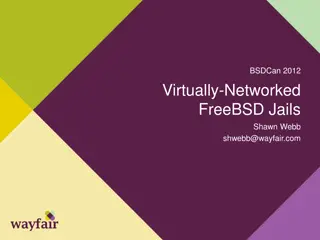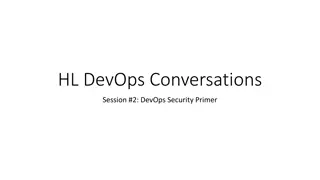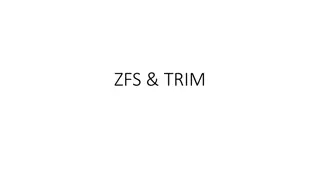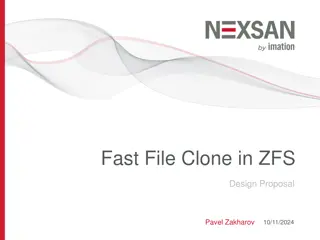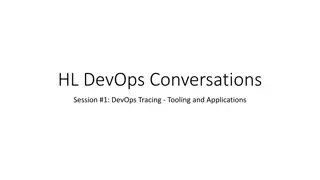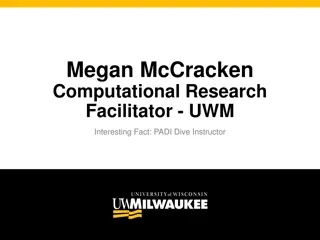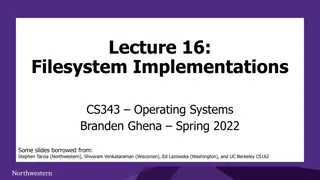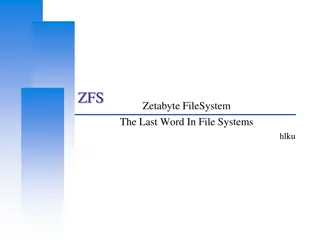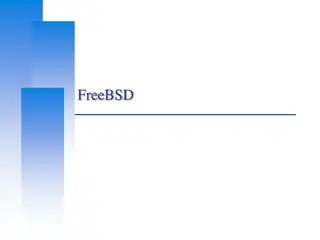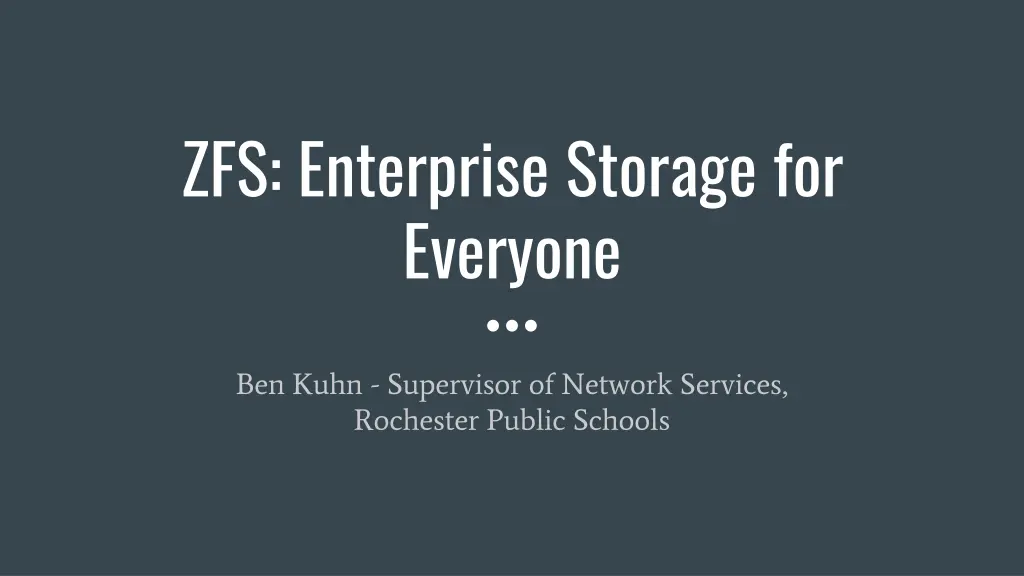
Unlocking the Potential of ZFS: A Comprehensive Overview
Explore the world of ZFS with insights on features, misconceptions, design considerations, and supported platforms. Learn about the history, benefits, and when not to use ZFS for optimal storage solutions.
Download Presentation

Please find below an Image/Link to download the presentation.
The content on the website is provided AS IS for your information and personal use only. It may not be sold, licensed, or shared on other websites without obtaining consent from the author. If you encounter any issues during the download, it is possible that the publisher has removed the file from their server.
You are allowed to download the files provided on this website for personal or commercial use, subject to the condition that they are used lawfully. All files are the property of their respective owners.
The content on the website is provided AS IS for your information and personal use only. It may not be sold, licensed, or shared on other websites without obtaining consent from the author.
E N D
Presentation Transcript
ZFS: Enterprise Storage for Everyone Ben Kuhn - Supervisor of Network Services, Rochester Public Schools
About me Why should you listen to a network guy talk about storage?
What is ZFS? ZFS was always more of a ZFS was always more of a buzzword than anything else buzzword than anything else https://arstechnica.com/gadgets/2020/01/linus-torvalds-zfs-statements-arent-right-heres-the-straight-dope/
What is ZFS Really? Image source: https://louwrentius.com/tag/zfs2.html
A Brief History of ZFS ZFS development is started by 2 engineers at Sun Microsystems Apple s ZFS development ends. MacZFS project begins. Apple started porting ZFS to Mac OS X. OpenZFS project announced First stable release of ZFS on Linux 2001 2007 2009 2013 2013 2013 2008 2010 2005 OpenSolaris discontinued. Code is forked and illumos project continues open ZFS development A port to FreeBSD was released as part of FreeBSD 7.0. A native Linux port is started Source code was released as part of OpenSolaris OpenZFS on OS X Ports ZFS on Linux to OS X http://open-zfs.org/wiki/History
ZFS Features Online Pool Expansion Data Checksums and Self-Healing Compression Deduplication Quotas and Reservations Thin-provisioning Snapshots Cloning Replication Virtual Block Devices SSD Caching (storage tiering)
ZFS Misconceptions 1. 2. 3. 4. 5. 6. 7. 8. Linus said not to use it ZFS needs lots of RAM ZFS requires expensive ECC Ram ZFS isn t fast ZFS isn t flexible I need specific hard drives You can t add drives to a pool For maximum performance, your number of drives limits VDEV types.
When shouldnt you use ZFS? If you want to mix and match drive sizes *AND* need every free gigabyte of space If you are adding or remove single drives on a regular basis and need redundancy If you have less than 4GB ram in the system
Workload Considerations IOPS, throughput, and latency
What is your workload? Data Backup or file shares Database server Throughput more important than IOPS Use RAIDZ(5) or RAIDZ2(6) level based on criticality of data IOPS are critical Use Striped Mirrors (RAID10) Consider SSD caching (more on this later) iSCSI Host for VM storage Networked Video Recorder Required IOPS based on number of VMs Low latency is critical Hopefully you have adequate backups Use Striped Mirrors (RAID10) for best performance Data is streamed so IOPS are minimal Throughput is very important to minimize latency and prevent dropped frames Consider striping over several RAIDZ or RAIDZ2 VDEVs
Calculating IOPS and Throughput: Stripes and Mirrors N-wide striped: N-way mirror: Read IOPS: N * Read IOPS of a single drive Write IOPS: N * Write IOPS of a single drive Streaming read speed: N * Streaming read speed of a single drive Streaming write speed: N * Streaming write speed of a single drive Storage space efficiency: 100% Fault tolerance: None! Read IOPS: N * Read IOPS of a single drive Write IOPS: Write IOPS of a single drive Streaming read speed: N * Streaming read speed of a single drive Streaming write speed: Streaming write speed of a single drive Storage space efficiency: 50% for 2-way, 33% for 3-way, 25% for 4-way, etc. [(N-1)/N] Fault tolerance: 1 disk per vdev for 2-way, 2 for 3-way, 3 for 4-way, etc. [N-1] Use the specifications of your slowest drives in these formulas https://www.ixsystems.com/blog/zfs-pool-performance-1
Calculating IOPS and Throughput: RAIDZ N-wide RAIDZ, parity level p: Read IOPS: Read IOPS of single drive Write IOPS: Write IOPS of single drive Streaming read speed: (N p) * Streaming read speed of single drive Streaming write speed: (N p) * Streaming write speed of single drive Storage space efficiency: (N p)/N Fault tolerance: 1 disk per vdev for Z1, 2 for Z2, 3 for Z3 [p] Use the specifications of your slowest drives in these formulas https://www.ixsystems.com/blog/zfs-pool-performance-2
Calculating IOPS and Throughput: Multiple VDEVS More Complex setups Multiple VDEVS can be added in to a pool (RAID10, RAID50, etc ) Read IOPS: N * Read IOPS of slowest VDEV Write IOPS: N * Write IOPS of slowest VDEV Streaming read speed: N * Streaming read speed of a slowest VDEV Streaming write speed: N * Streaming write speed of a slowest VDEV Fault tolerance: If one VDEV fails the pool is lost. Use the specifications of your slowest drives in these formulas https://www.ixsystems.com/blog/zfs-pool-performance-1
Special VDEVs SLOG devices L2ARC devices Write Cache (Intent Log) device MUST be faster than your disks Useful for applications demanding synchronous writes (databases) Data is moved from the SLOG to the pool in the background. Use 2 for redundancy Read Cache device Lives between L1ARC in RAM and your disk pool MUST be faster than your disks Does not need to be redundant FILO ring buffer for L1ARC Does not persist between reboots Might not be worth using (yet)
Creating a pool # zpool create PoolName -o ashift=12 compression=lz4\ mirror /dev/sdb1 /dev/sdc1\ mirror /dev/sdd1 /dev/sde1 Use Partitions instead of full disks (full disks are supported, however). Pay attention to disk block size. Force 4K blocks with ashift=12, 8K blocks (Samsung SSDs) with ashift=13. This pool will mount at /PoolName. The mountpoint= flag will change this. LZ4 compression is enabled. Only compressible blocks will be compressed.
Creating a filesystem # zfs create PoolName/FSName # zfs create -o compression=off PoolName/FSName/ChildFS By default, options applied to the parent will be applied to child filesystems (pool options will apply to all filesystems in the pool) Options can be overridden or changed on a per-filesystem basis The first example will mount at /PoolName/FSName. The second mounts at /PoolName/FSName/ChildFS The mountpoint= flag will change this. LZ4 compression is disabled on the second example.
Destroying Pools and Filesystems # zfs destroy -r PoolName/FSName # zpool destroy PoolName Use the -r flag for a recursive destroy (including snapshots). The top example destroys PoolName/FSName/ChildFS from our previous example as well.
Commercial Offerings and Support iX Systems - TrueNAS and FreeNAS storage appliances. https://ixsystems.com Canonical - ZFS is shipped with the Ubuntu distro. https://ubuntu.com Proxmox - Proxmox Virtual Environment https://proxmox.com Rsync.net - ZFS Replication to the cloud. https://rsync.net Great Lakes SAN - Storage appliances and off-site backup. https://glsan.com Oracle - ZFS Storage Appliance. https://www.oracle.com/storage/nas Spectra Logic, Datto, and many others - http://open-zfs.org/wiki/Companies
Additional Resources Techsnap Podcast - https://techsnap.systems BSDNow Podcast - https://bsdnow.tv OpenZFS Wiki - https://open-zfs.org/wiki/Main_Page iX Systems Blog - https://www.ixsystems.com/blog Jim Salter s Blog - https://jrs-s.net/category/open-source/zfs/

